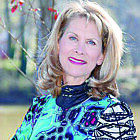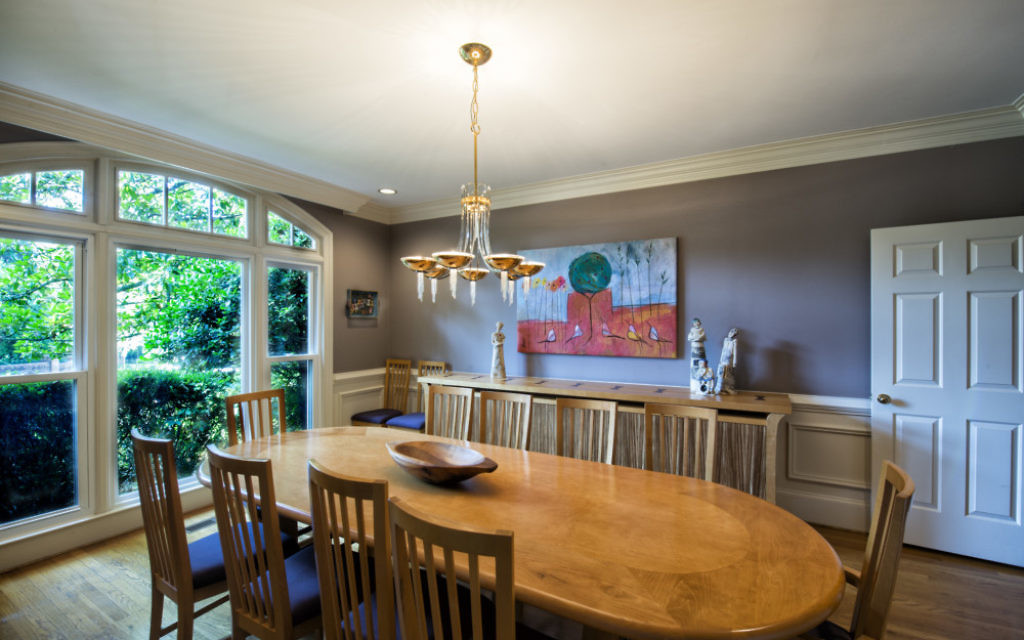Chai Style Homes: Sculptor Balances Eclectic Collection With Whimsy
In the Robkin household in Sandy Springs, small details make a big difference. The space is warm and alive as the wood, expert fiber crafting and the artist’s own sculpture speak of informed design. It is neither static nor solid, but breathing with movement and spirit of place.
Judy Robkin started creating later in life and bounces off her whimsical vision of finely crafted clay with a grandmotherly touch. She taught art for 15 years at the John C. Campbell folk school in Murphy, N.C., as well as at the Weber School.
Get The AJT Newsletter by email and never miss our top stories Free Sign Up
Jaffe: I see a lot of fine and substantial wood flourishes. How did you employ Cuban-born Israel Peljovich?

Robkin: Peljovich is a major local talent, master craftsman, and happens to be married to my cousin Lidia. Look at the detail in this custom dining table and buffet. In the kitchen we have more of his maple bookshelves and breakfast nook table set. We renovated the kitchen, enjoy entertaining and consider 20 guests for dinner nothing for me. We often have two or three events a week here.
Peljovich: I am excited when a client like Judy gets deeply involved. We put our two heads together and came up with the intricate mahogany bowties and zebra wood in the dining room. I also created a moving showroom for her.
Jaffe: What is your own artistic vision, and from where did it stem?
Robkin: I remember as a child, my father (Henry Birnbrey) always encouraged me to learn how to make and fix things on my own. Even plumbing repairs I try to figure out. He had a wood workshop and taught me to be fearless and challenge my mind to conquer the task. My sister, Anita Stein, is a talented pastel artist who does landscapes in plein air settings. Actually, I started sculpting in my late 30s, rather late in life.
Jaffe: You’re a Jewish Grandma Moses. What happens here in your workshop?
Robkin: I start with flat slabs of clay and begin rolling it. It just happens. Each piece is fired at least three times for around seven to 10 hours each. My clay figures are hand-built, one-of-a-kind ladies with depth and detail of hidden openings of antique photos, vintage tin types or artifacts. They are individually named like this “Rebecca.”
My favorite texturizing tool is the inside of an old-fashioned pencil sharpener.
Before this series, I worked in raku, the Japanese smoke-firing technique requiring firing to 2,000 degrees and careful removal from the kiln while they are still hot and glowing. I find that Atlanta is a traditional, conservative art scene, and I prefer to show in fine art shows around the South or Northeast, anywhere I can load up a U-Haul. Things sell pretty quickly.
Jaffe: This is a multigenerational household. How does that work?
Robkin: My daughter, her husband and their two children live in our lower level. We are almost kibbutzlike, sharing cooking and child care. My daughter, who works for Emory Global Health Institute and is engaged in research funded by the Gates Foundation, travels to far-off places like Kenya, Mozambique and South Africa. Their goal is to study childhood mortality.
Jaffe: Explain your affinity for texture and often whimsy.
Robkin: I buy what I like — that which is interesting and fun. I treasure this 25-year-old mirror by Sticks from the New Morning Gallery in North Carolina. You spin the dial to select dream, share, accept change, be in love, see the world, etc. “Life is a banquet and your wishes too” is scripted at the bottom.
Some of my other favorites are the pastel quilt made out of panty hose in the family room, a vibrant textile by John Gunther contrasting the original Chippendale desk in our great room, and the embroidery designed by a Jewish Ethiopian fashion designer in New York, Hiroots Yoseph, and embroidered by her sister, Maritu Enyew, who sat at her mother’s feet as a young girl to learn the craft.
Jaffe: What are the origins of your favorite pieces?

Robkin: Ah, too numerous to count. Rio, Montevideo, China and Dubrovnik. But mostly I’d say Israel.
In the dining room, see the eclectic folk primitive triptych of blessings by French Israeli Eliyahu Sidi; the blessings are bitter herbs, the bridal chuppah and miracles. The drawing by David Schneuer and the dyed wool bird fabric are both Israeli. In the kitchen we have Genesis: “Seven Days of Creation” by Moshe Monzon. Heading up the stairs is an acrylic, “The Sea of Galilee,” by Israeli artist Amram Ebgi.
Jaffe: Your daughter’s wall-sized chuppah is a major wow. How did you create it?
Robkin: I wanted to express her affinity for Africa and also incorporate the scarves (see the tiny leaves) from her four grandmothers. It took three months to complete, and I consulted a mathematician to design the spokes of the circle to be symmetrical. By the way, their wedding was on an organic farm in Israel with a Balkan marching band.
Jaffe: Being in an observant and tactile home like this gave photographer Duane Stork and me the chutzpah to ask whether we could be on the guest list for homemade challah and Shabbos dinner.






comments